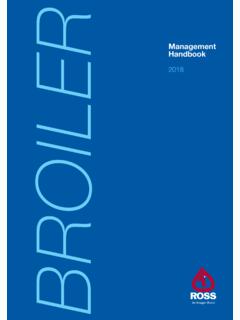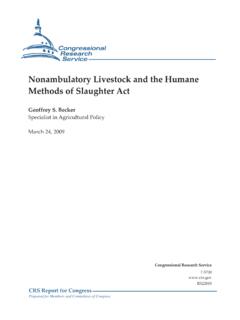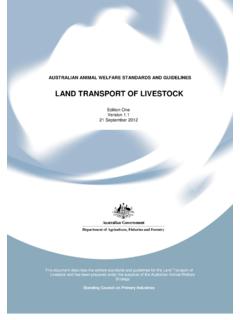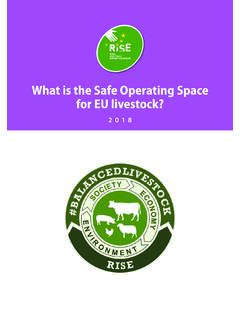Transcription of 50 Years of Selection Article-final - Aviagen | Aviagen
1 A Brief History of Broiler Selection : How Chicken Became a Global Food Phenomenon in 50 Years Dominic Elfick, International Product Manager, Aviagen International A $44 Billion industry Emerges Around the world, the broiler industry consumes approximately 417 million parent stock (PS) per year , the equivalent of some 58 billion broilers. The US industry alone now generates over US$44 billion in annual retail sales, according to the USDA. Although US-based commercial broiler production started the 1920s, the effort to genetically improve commercial stocks didn t begin in earnest until the 1940s.
2 And it would be another 20 Years before independent sales of these birds was common. Over the Years , quality and efficiency efforts have paid off. The inflation-adjusted cost of producing a pound of live chicken dropped from US$ in 1934 to US$ in 1960. In 2004, the per-pound cost had dropped to 45 cents, according to the USDA Poultry Yearbook (2006). Within flocks themselves, genetic Selection has largely driven broiler performance, with improvements in nutrition, veterinary science and environmental control also contributing to improved bottom line performance.
3 Beyond Weight and Growth Rates: Selection Criteria Evolve In 1945, the American grocer A&P (Atlantic & Pacific Tea Company) organized the first of its Chicken of Tomorrow contests. Qualifying trials were conducted in 1946 and 1947 with the national finals held in 1948. For the finals, breeders submitted a case of 30 dozen hatching eggs to an Eastern Shore hatchery, where the eggs were hatched and the offspring fed until they reached market weight and were then slaughtered. Broilers were judged on several factors, including growth rate, feed conversion efficiency, and the amount of meat on breasts and drumsticks.
4 Though held only three times, the contests enabled breeders such as Peterson, Vantress, Cobb, Hubbard, Pilch and Arbor Acres to become established market brands. The initial breeders relied only on mass Selection or selecting an individual based purely on its own characteristics. And because the original purpose of most birds was to grow large quickly, breeders used weight by choosing the heaviest males and females as the primary Selection criterion. They also found that weight was moderately heritable, where 20 to 40 percent of the trait was genetically controlled.
5 Though simple, this Selection process helped improve broiler breeder performance across the generations. Market forces have changed Selection criteria over the Years . A more integrated and consolidated industry learned that weight and growth rates alone could not be the only Selection criteria considered. This was particularly true as feed costs rose: Today, feed accounts for between 65 and 70 percent of the input cost for a broiler. As a result, Selection for feed efficiency became a must. As breeders better understood negative correlations between growth and reproductive traits, breeders looking to produce chicks cost effectively, began evaluating such criteria as egg production and hatchability also became increasingly important.
6 With these negative correlations at play in most breeding companies Selection objectives, mass Selection was no longer an effective Selection tool and the use of Selection Index theory, where information on family members was taken into account, became the norm. Changes and Consolidation in the 80s and 90s The United States and Europe the major markets for chicken meat matured in the 80s and early 90s, leading retailers to shift from selling eviscerated carcasses to tray pack, a trend that made components of yield more important than purely whole bird yield.
7 As markets mature further, there is also a shift from tray-pack fresh meat to more further-processed products, with a greater emphasis on breast meat yield in the most developed markets. Also during this time, the major westernized markets for chicken became increasingly focused on bird welfare and food safety. With the increasingly complex Selection objectives required of the breeders, Selection programs began incorporating BLUP (Best Linear Unbiased Prediction) Selection tools, which weigh individual and family performance while evaluating how traits relate to one another.
8 Some breeders were better than others at incorporating BLUP Selection tools. Those variations, the need for high levels of R&D spending and the capital intensive nature of the business prompted consolidation within the primary breeder industry . By the late 2000s only three sizable breeding groups remained: Cobb-Vantress (with the Cobb, Avian, Sasso and Hybro brands), Aviagen (with the Ross, Arbor Acres, Lohmann Indian River and Peterson brands), and Groupe Grimaud (with the Hubbard and Grimaud Frere brands). Today the history of the industry continues to influence Selection criteria, with growth still important throughout most of the world and feed efficiency a high priority.
9 The ability to produce broiler breeders with an economically viable number of eggs and chicks remains important, and becomes increasingly so as companies become more integrated. Meat yield of cuts and the fitness of modern broiler breeder are also crucial to the industry s continued success. Sustainability Becomes a Priority Sustainability has become the watchword of the early 21st Century. Increasingly, breeders ask, Can the breeding program continue to produce purpose-fit birds in the face of increasingly scarce and costly resources?
10 Accumulations of leg health issues, poor immune responses, high feed intake or high outputs of waste product are today not considered acceptable for a long-term sustainable breeding program, let alone for the birds being bred. For breeding programs, sustainability and welfare surround four basic issues: 1) Does it safeguard human health? 2) Does it ensure that the animal is bred with due regard to its health and welfare? 3) Does it further the financial success of the customer? 4) Does it improve the long-term sustainability of the industry ?












